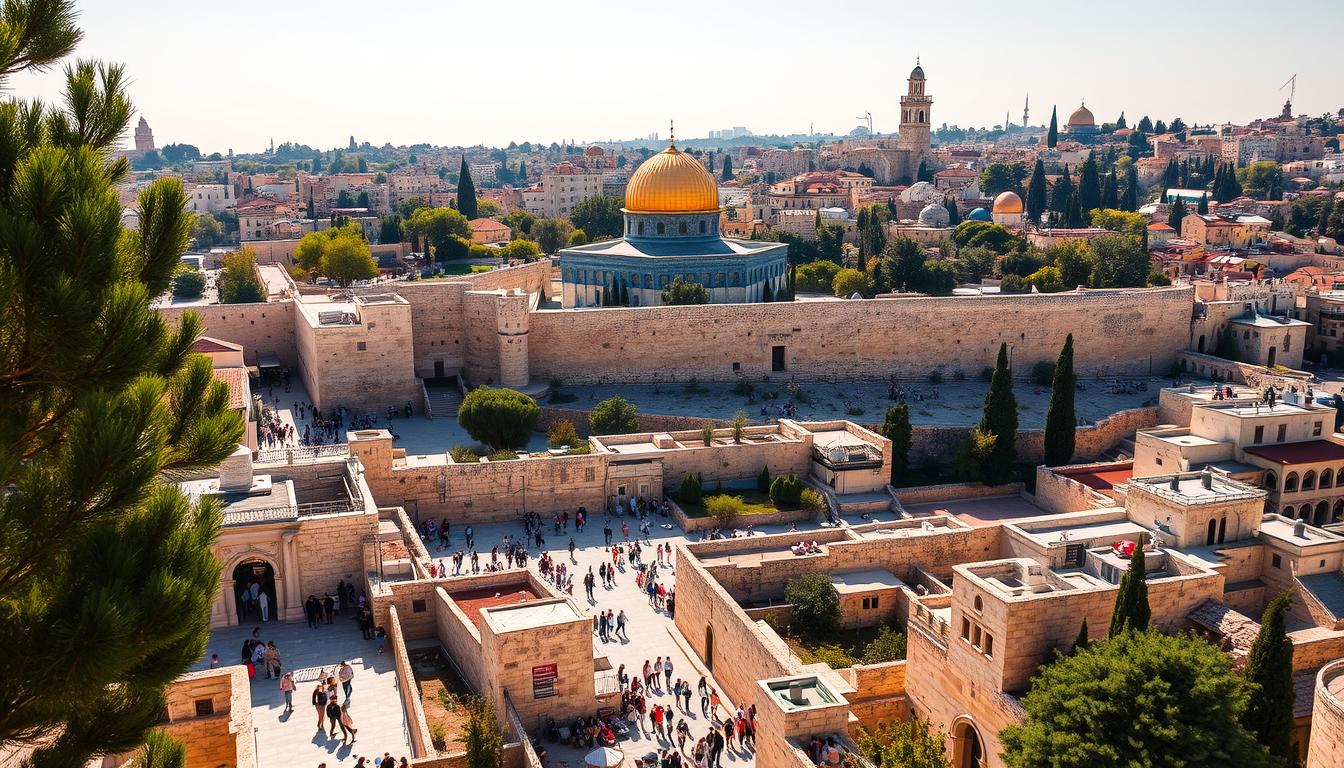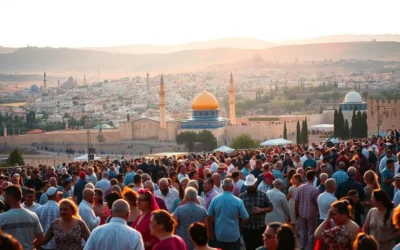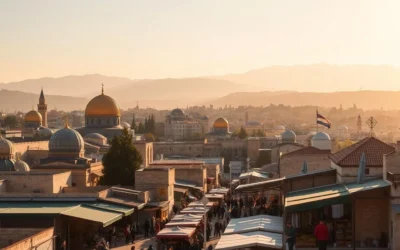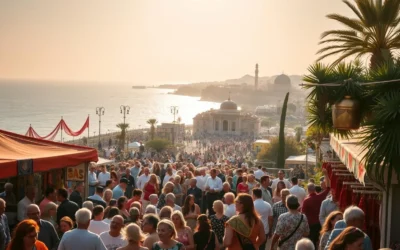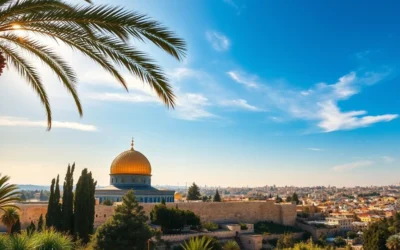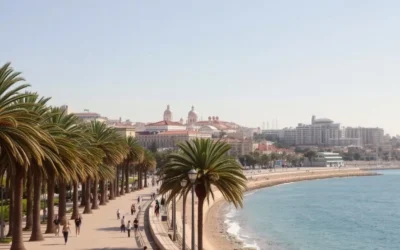What do you think of when you hear Jerusalem? Do you imagine ancient religious sites, a lively cultural scene, or a history that goes back thousands of years? This city, one of the oldest in the world, offers a travel experience like no other. It takes you beyond time and belief.
Jerusalem’s dusky white stone walls and deep religious meaning grab your attention. It invites you to start a journey of discovery. You can dive into the city’s history, explore its art scene, or watch the daily life of ultra-orthodox Jews. This city promises an adventure you won’t forget. But what makes Jerusalem so unique, and what are the top experiences you must have?
Key Takeaways
- Jerusalem is one of the oldest cities in the world, known for its diverse religious significance and rich history.
- The city features stunning architecture, including dusky white stone walls, and is home to various religious sites.
- Jerusalem has a vibrant art scene and offers unique cultural experiences, such as observing ultra-orthodox Jews in traditional attire and learning about Shabbat celebrations.
- The city’s weather can vary significantly, with cold and rainy conditions possible even in February.
- Jerusalem is a safe destination for families, with comprehensive public transportation and opportunities for flexible exploration with a rental car.
Discovering the Magic of Jerusalem: An Introduction
Jerusalem is a city in the Middle East that draws visitors with its old charm and lively culture. When planning your trip, knowing the best time to go and how to get around is key.
Best Time to Visit Jerusalem
The best seasons to visit Jerusalem are spring and fall. The weather is mild, with temperatures between 60°F and 75°F. This makes it great for exploring the historic streets and enjoying the city’s vibe.
Summer is hot and humid, while winter is chilly and rainy. You’ll need warm clothes and a rain jacket during these months.
Getting Around the City
Jerusalem’s public transport is easy to use. The Jerusalem Light Rail is a good way to see major sights. The Egged bus network also covers many areas.
Taxis and ridesharing are available for a more personal trip. Just make sure to agree on the fare first.
Cultural Etiquette Tips
- Dress modestly, especially at religious sites, to show respect.
- Be aware of religious practices and avoid disrupting sacred areas.
- Learn about local customs to have a respectful and fun trip.
Jerusalem is a mix of old and new, with unique decor and modern infrastructure. By knowing when to visit, how to get around, and respecting local customs, you’ll enjoy the city’s magic.
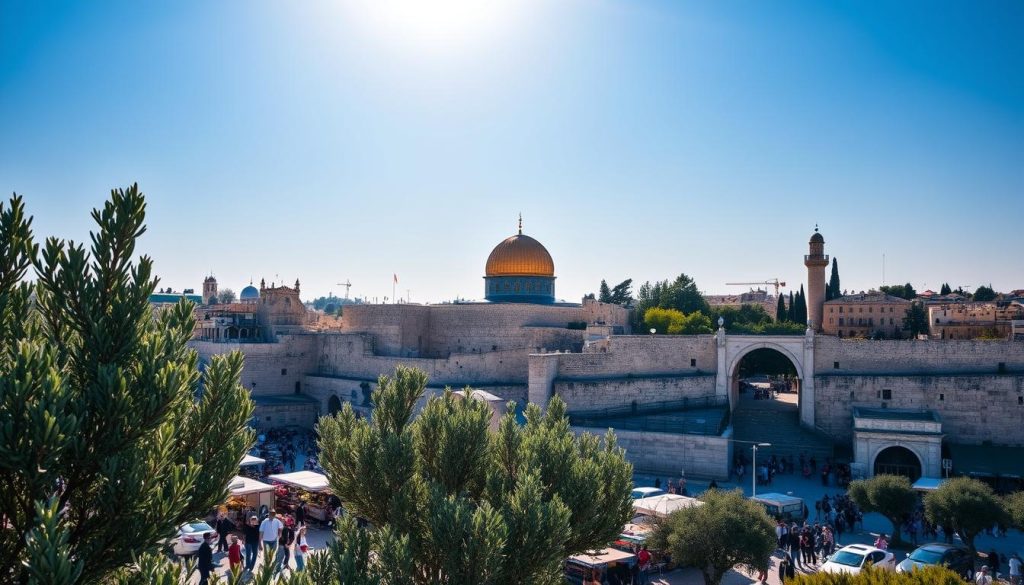
Old City of Jerusalem: A Journey Through Time
The Old City in Jerusalem is a UNESCO World Heritage site. It takes visitors back in time. This ancient area has four quarters: Jewish, Christian, Muslim, and Armenian. It shows the city’s rich and complex history.
The Old City of Jerusalem is full of amazing buildings. Each one shows the different cultures and religions that have influenced it. You can see old stone walls, paved paths, and beautiful religious buildings everywhere.
Archaeologists are always finding new things about the city’s past. They help us learn about the many people and faiths that lived here. Visitors can see old ruins, follow in the steps of biblical figures, and experience traditions that have lasted for centuries.
The Old City of Jerusalem is a special place for anyone interested in history, faith, or just exploring. Its streets, markets, and famous sites invite you to discover its history and architecture.
“The Old City of Jerusalem is a living, breathing testament to the power of faith, resilience, and the enduring human spirit.” – Anonymous
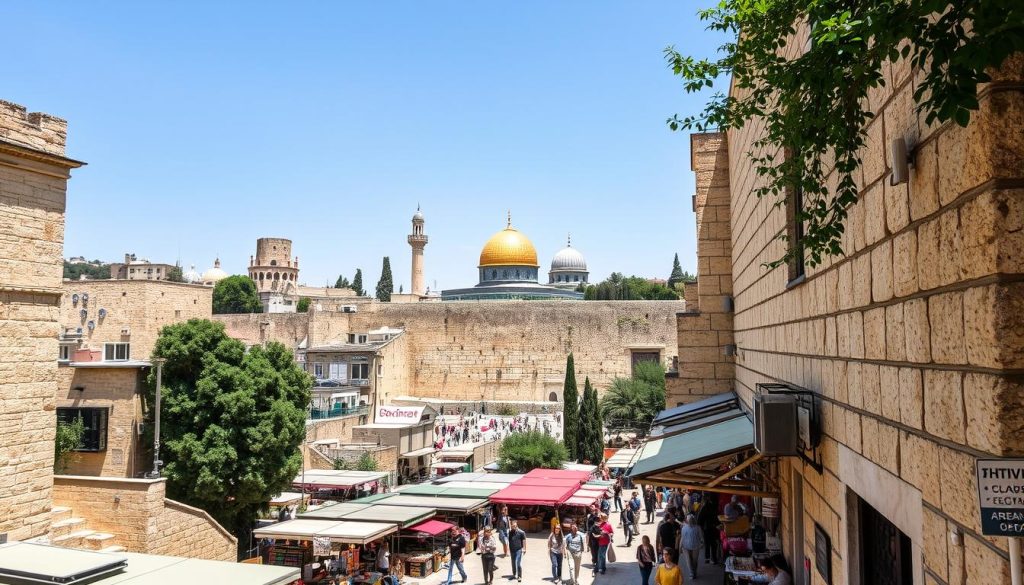
In the Old City, you’ll see old and new, sacred and secular together. The ancient walls and the lively markets show the city’s mix of history, culture, and spirituality.
Exploring the Church of the Holy Sepulchre, the Dome of the Rock, or the Jewish Quarter is unforgettable. The Old City of Jerusalem is a journey through time you won’t forget.
| Key Highlights of the Old City of Jerusalem | Significance |
|---|---|
| Tower of David Museum | Offers a comprehensive overview of the city’s history and showcases the stunning Night Spectacular light show |
| City of David | Archeological site dating back over 6,000 years, revealing the ancient roots of Jerusalem |
| Wailing (Western) Wall | A revered Jewish holy site and one of the most important pilgrimage destinations in the world |
| Dome of the Rock | An iconic Islamic shrine and one of the most recognizable landmarks in Jerusalem |
Exploring the Old City of Jerusalem takes you through its history and architecture. You’ll discover the layers of meaning that make this UNESCO World Heritage site so special.
Temple Mount and Western Wall Experience
Jerusalem’s Temple Mount and the Western Wall are key spots for anyone visiting this ancient city. They are sacred for Jews, Christians, and Muslims. These places are filled with deep spiritual and historical meaning.
Western Wall Prayer Customs
The Western Wall is the most sacred place for Jewish prayer. People from all over come to pray and connect with their heritage. Men and women pray in different areas. Many leave prayers in the wall’s cracks, hoping they reach heaven.
Temple Mount Visiting Hours
The Temple Mount, where the Al-Aqsa Mosque is, has strict rules. Non-Muslims can only visit during certain times. It might close suddenly for security or religious reasons. Always check the schedule and be ready for changes.
Dress Code and Regulations
Visitors must dress modestly at the Temple Mount and Western Wall. Women need to cover their heads. Both men and women should wear clothes that cover shoulders and knees. It’s important to respect the site’s religious and political nature.
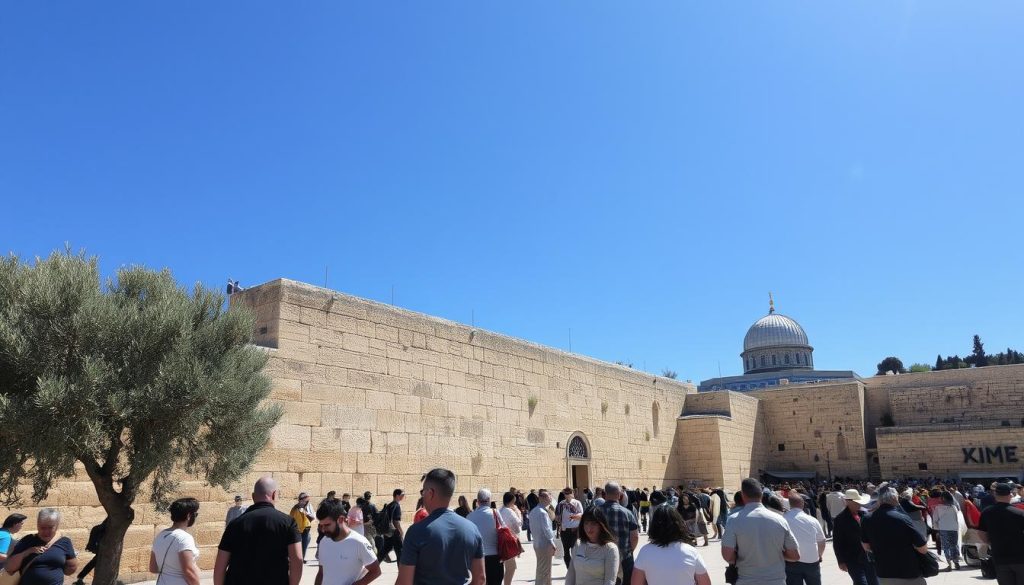
Exploring the Temple Mount and Western Wall is a deep and rewarding journey. By learning about the customs and history, you’ll appreciate Jerusalem’s rich heritage more.
Church of the Holy Sepulchre: Sacred Christian Site
The Church of the Holy Sepulchre in Jerusalem is a sacred place for Christians everywhere. It’s believed to be where Jesus Christ was crucified, buried, and rose again. This 4th-century church is a key spot for those interested in the Christian history of the Holy Land.
Several Christian groups, like Greek Orthodox, Roman Catholic, and Armenian Apostolic, share control of the church. Each group has its own chapels and traditions. Visitors see pilgrims praying and touching sacred spots like the Stone of Unction and the Tomb of Christ.
Even though debates exist about the exact spots of key events, the Church of the Holy Sepulchre is deeply moving. Its history and spiritual power make it a key stop for those exploring Christian sites in Jerusalem.
“The Church of the Holy Sepulchre is one of the most sacred and significant Christian sites in Jerusalem. Its history and spiritual significance make it a profound and moving experience for all who visit.”
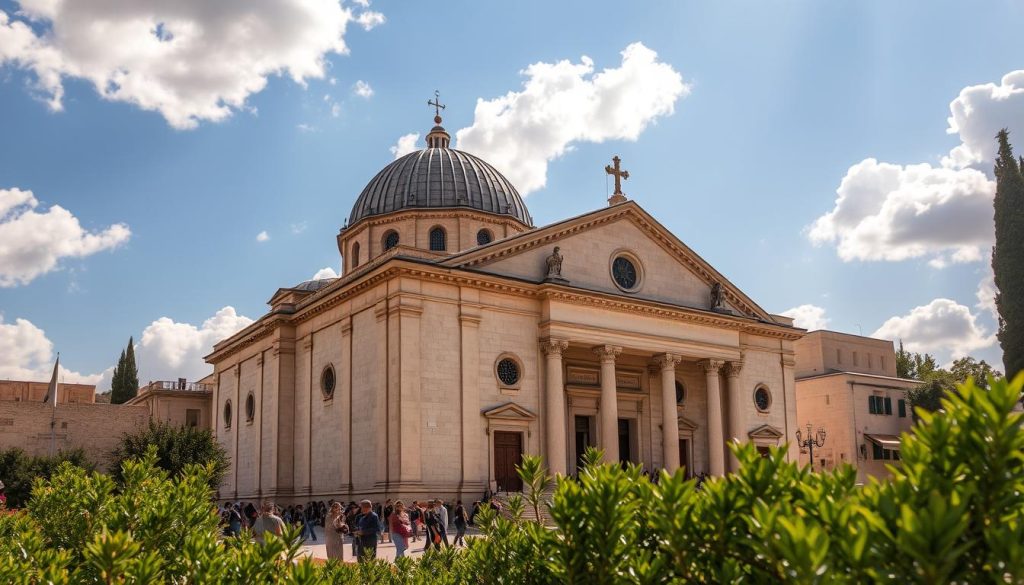
| Notable Christian Sites in Jerusalem | Significance |
|---|---|
| Church of the Nativity, Bethlehem | Built around the Holy Grotto where Jesus was born |
| Qasr el-Yehud, near Jericho | Authentic baptismal site on the River Jordan |
| Church of the Beatitudes, Mount of Beatitudes | Site of Jesus’ Sermon on the Mount |
| Church of the Holy Sepulchre, Jerusalem | Site of Jesus’ crucifixion, burial, and resurrection |
Jerusalem, Israel: Best Things to Do – Top Picks
Religious Sites and Attractions
Jerusalem is filled with religious history. Exploring its sacred sites is a must. Start at the Western Wall, a key site for the Jewish people. It attracts thousands of prayers every week.
The Temple Mount is another must-see. It was home to the Second Temple of Jerusalem. This temple was 160 feet long and 60 feet high.
For Christians, the Church of the Nativity in Bethlehem is a must-visit. It’s believed to be Jesus’s birthplace since 2 AD. The Church of the Holy Sepulcher in Jerusalem is also a key site. It’s where Jesus was crucified, according to tradition.
The Al Aqsa Mosque is a significant Islamic site. It was built around 710 AD. It can hold up to 5000 worshippers.
Cultural Experiences
Jerusalem has more than just religious sites. The Old City is full of life. Its narrow streets and vibrant atmosphere are unforgettable.
Visit museums like Yad Vashem to learn about the city’s history. You can also join local festivities and workshops. Try a hummus-making class or a pub crawl with Abraham Tours.
Food and Market Tours
Jerusalem’s food scene is vibrant. Visit the Mahane Yehuda Market to try local delicacies. The market’s lively atmosphere is infectious.
Join a guided food tour to explore Jerusalem’s culinary world. From traditional dishes to modern fusion, there’s something for everyone.
Jerusalem has something for everyone. Whether you’re interested in history, culture, or food, there’s plenty to discover. With some planning and a sense of adventure, you’ll make memories that last a lifetime.
Exploring Mahane Yehuda Market
Step into the vibrant heart of Jerusalem at the Mahane Yehuda Market, also known as “The Shuk.” This bustling marketplace is a true feast for the senses. It offers a captivating blend of sights, sounds, and flavors that reflect the city’s diverse cultural heritage.
By day, the market is a dazzling display of fresh produce, fragrant spices, artisanal baked goods, and local delicacies. Vendors hawk their wares, inviting you to explore the rich tapestry of Jerusalem’s food market. You can immerse yourself in the city’s culinary traditions.
As the sun sets, the market transforms into a lively Jerusalem nightlife scene. Many stalls convert into vibrant bars and restaurants. This is where you can savor the best of local cuisine, from traditional Jewish specialties to modern Israeli dishes, all while soaking up the electric atmosphere.
Whether you’re looking to indulge in a Mahane Yehuda Market food tour, participate in a cooking workshop, or simply wander and soak in the sights, sounds, and aromas, this iconic marketplace is a must-visit destination. It’s a must-see for anyone exploring the wonders of Jerusalem.
“Mahane Yehuda Market is a culinary and cultural hub that captures the essence of Jerusalem’s diversity and vibrant energy.”
From the fragrant spice stalls to the lively nightlife, the Mahane Yehuda Market offers a truly immersive experience. It will delight your senses and leave you with lasting memories of your time in this captivating city.
Mount of Olives and Garden of Gethsemane
The Mount of Olives is in the heart of Jerusalem. It offers a stunning view of the Old Town. This place is important in Jewish, Christian, and Muslim traditions.
At the top, you see the Dome of the Rock and the Old City’s ancient walls. These sights are unforgettable.
Panoramic Views
Going up the Mount of Olives, you see the Old City. You’ll see the Temple Mount, the Western Wall, and the Church of the Holy Sepulchre. Seeing the city at sunrise or sunset is amazing.
The warm light makes the old buildings glow. It’s a sight that takes your breath away.
Historical Significance
The Mount of Olives is very important. It’s where Jesus prayed before his crucifixion in the Garden of Gethsemane. There are also ancient Jewish tombs here.
Today, people still bury their loved ones here. The graves are thousands of years old.
Photography Spots
Photographers love the Mount of Olives. The views and history make it perfect for photos. You can take pictures of the skyline, ancient olive trees, or the calm atmosphere.
It’s a place every photographer should see. The Mount of Olives is unforgettable.
“The Mount of Olives is a place of profound spiritual significance, where the past and present converge to create a truly remarkable experience.”
Yad Vashem: Holocaust Memorial
Yad Vashem is Israel’s official memorial to the Holocaust victims. It’s a large complex that reminds us of one of history’s darkest times. It’s the second most visited place in Israel, after the Western Wall.
This place shows the strength and will to never forget the tragedy that happened to the Jewish people. It’s a powerful symbol of their resilience.
The main museum at Yad Vashem tells the story of the Holocaust in detail. It takes you through artifacts, testimonies, and multimedia displays. The Children’s Memorial and the Hall of Names are especially moving.
They honor the memory of over 1.5 million murdered children. They also preserve over three million pages of testimony about actions against Jews during World War II.
Yad Vashem also has archives and research facilities. They work to keep the memory of Holocaust victims alive. They educate future generations about this important moment in Israel’s history.
Visiting Yad Vashem takes at least 2 hours. It’s not recommended for young children because of the intense subject matter. As the largest Holocaust museum, Yad Vashem is a solemn reminder of human resilience and the importance of remembering the past.
The above is subject to change.
Check back often to TRAVEL.COM for the latest travel tips and deals.
Here are some Tours & Sightseeing suggestions that might pique your interests!
